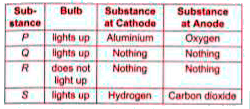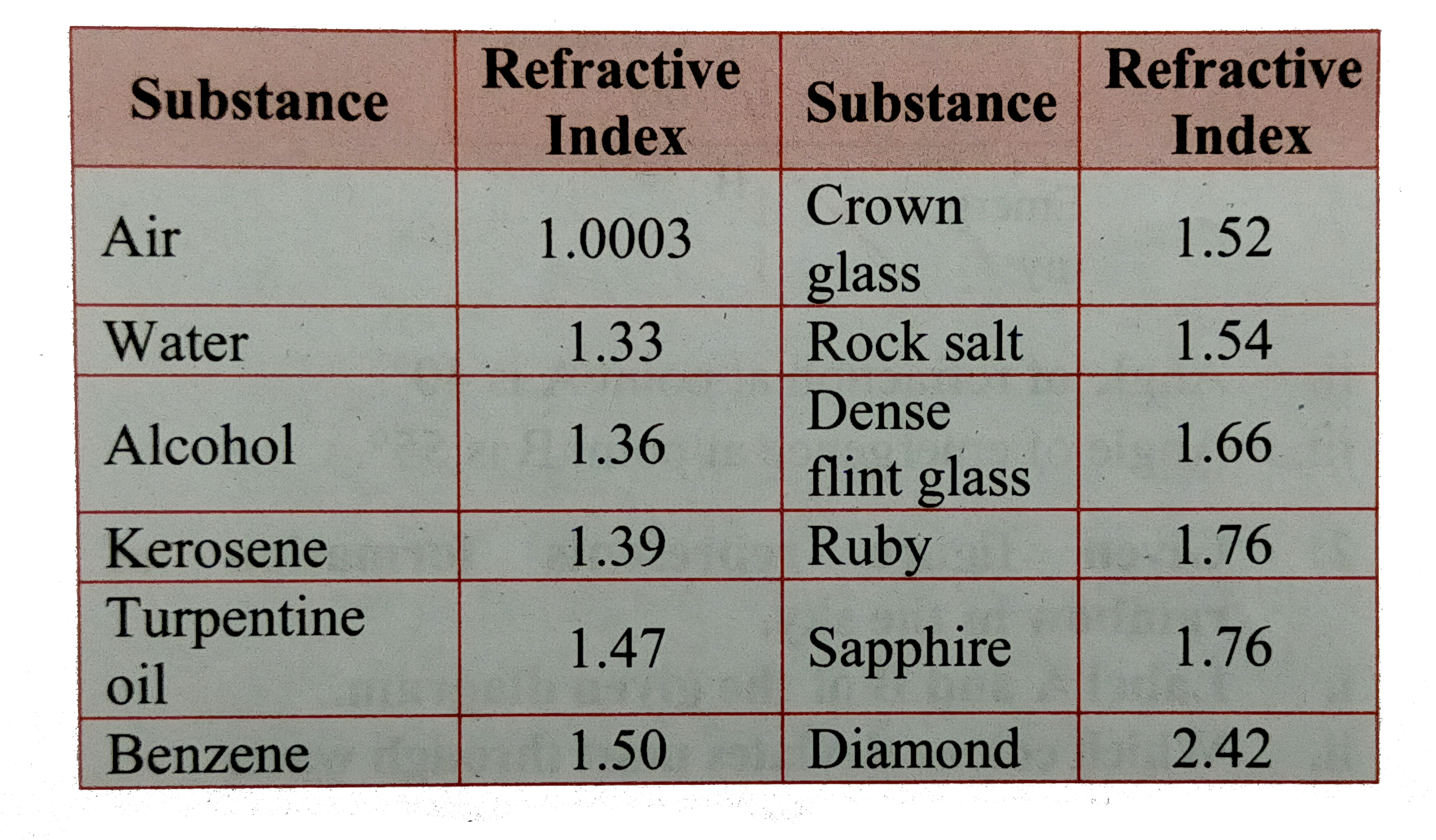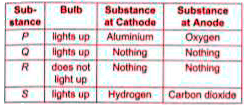Four substances were tested for their electrical conductivity by placing in contact with anode and cathode in a cell. The results are shown in the table. Study the table and answer the following questions.

In substance Q, bulb lights up but no substance is found either at cathode or at anode, why?
Because Q is non-electrolyte.
Because Q is an element which remains unchanged when it conducts electricity.
Because Q is an electrolyte that conducts electricity when it is in the molten state.
Because Q is a poor conductor of electricity.
The correct Answer is:B
Step by step video, text & image solution for Four substances were tested for their electrical conductivity by placing in contact with anode and cathode in a cell. The results are shown in the table. Study the table and answer the following questions. In substance Q, bulb lights up but no substance is found either at cathode or at anode, why? by Chemistry experts to help you in doubts & scoring excellent marks in Class 8 exams.
Updated on:21/07/2023Topper's Solved these Questions
- CHEMICAL EFFECTS OF ELECTRIC CURRENTBook:SCIENCE OLYMPIAD FOUNDATION Chapter:CHEMICAL EFFECTS OF ELECTRIC CURRENTExercise:ACHIEVERS SECTION (HOTS)
Explore 5 Videos
- COAL AND PETROLEUMBook:SCIENCE OLYMPIAD FOUNDATION Chapter:COAL AND PETROLEUMExercise:MULTIPLE CHOICE QUESTION (ACHIEVERS SECTION (HOTS))
Explore 5 Videos
Similar Questions
A group of materials 'P' can be sub-divided into three groups 'Q', 'R' and 'S' as the basis of their characteristics The substance belonging to group 'Q' may be solid, liquids and gases. These are poor conduction of electricity. The substances included in group 'R' are solids which are good conductors of electricity. Group 'S' consists of substances which have the characteristics common to the substances belonging to groups 'Q' and 'R'.
Based upon the above observations, answer the following questions :
(a) To which class of substances materials present in group 'P' belong ?
(b) Name the type of substances 'Q'. Give two examples.
(c ) Name the type of substances 'R'. Give two examples.
(d) Name the type of substances 'S'. Give two examples.
View SolutionEkta and Vaibhav performed an experiment and found refractive indices of various media as mentioned in the following table. Observe the table and answer the questions based on it.

Arrange the following substances from denser to rarer medium. Benzene, Alcohol, Water, Turpentine oil, Rock salt
View Solution
Knowledge Check
Four substances were tested for their electrical conductivity by placing in contact with anode and cathode in a cell. The results are shown in the table. Study the table and answer the following questions.

Which solutions could be alumina and magnesium nitrate respectively?AP and QBR and QCP and SDP is the alumina but none of P, Q, R, S is magnesium nitrate.Electrolysis is the process in which electrical energy is converted to chemical energy. In electrolytic cell, oxidation takes place at anode and reduction at cathode. Electrode process depends on the electrode taken for electrolysis. Amount of substance liberated at an electrode is directly propertional to the amount of charge passed through it. The mass of substance liberated at electrode is calculated using the following relation :
m=ItE96500
Here, E represents the equivalent mass and 96500 C is called the Faraday constant. Faraday (96500 C) is the charge of 1 mole electron, i.e., 6.023×1023 electrons, it is used to liberate one gram equivalent of the substance.
The passage of current liberates H2 at cathode and Cl2 at anode. The solution is :Acopper chloride in waterBNaCl in waterCmercuric chloride in waterDAuCl3 in waterElectrolysis is the process in which electrical energy is converted to chemical energy. In electrolytic cell, oxidation takes place at anode and reduction at cathode. Electrode process depends on the electrode taken for electrolysis. Amount of substance liberated at an electrode is directly propertional to the amount of charge passed through it. The mass of substance liberated at electrode is calculated using the following relation :
m=ItE96500
Here, E represents the equivalent mass and 96500 C is called the Faraday constant. Faraday (96500 C) is the charge of 1 mole electron, i.e., 6.023×1023 electrons, it is used to liberate one gram equivalent of the substance.
Calculate the volume of gas liberated at the anode at STP during the electrolysis of a CuSO4 solution by a current of 1 A passed for 16 minutes and 5 seconds :A224 mLB56 mLC112 mLD448 mL
Read the given passage and answer the questions.
P, Q, R are different colourless solids, while S is a colourless solution. They are in random order) Sodium chloride (NaCl), Calcium Carbonate (CaCO3), Acetic acid (CH3COOH) and Phenolphthalein indicator. Small amount of the above substances were added in pairs (e.g. P with Q, Q with R etc.) to a small amount of water in a test tube. They give the following results as shown in the observation table.
Observation Table:

If acetic acid and hydrochloric acid of same concentration are taken, HCl is a stronger acid because it contains:
View SolutionElectrolysis is the process in which electrical energy is converted to chemical energy. In electrolytic cell, oxidation takes place at anode and reduction at cathode. Electrode process depends on the electrode taken for electrolysis. Amount of substance liberated at an electrode is directly propertional to the amount of charge passed through it. The mass of substance liberated at electrode is calculated using the following relation :
m=ItE96500
Here, E represents the equivalent mass and 96500 C is called the Faraday constant. Faraday (96500 C) is the charge of 1 mole electron, i.e., 6.023×1023 electrons, it is used to liberate one gram equivalent of the substance.
On electrolysis of dilute sulphuric acid using platinum electrodes, the product obtained at the anode will be :
View SolutionElectrolysis is the process in which electrical energy is converted to chemical energy. In electrolytic cell, oxidation takes place at anode and reduction at cathode. Electrode process depends on the electrode taken for electrolysis. Amount of substance liberated at an electrode is directly propertional to the amount of charge passed through it. The mass of substance liberated at electrode is calculated using the following relation :
m=ItE96500
Here, E represents the equivalent mass and 96500 C is called the Faraday constant. Faraday (96500 C) is the charge of 1 mole electron, i.e., 6.023×1023 electrons, it is used to liberate one gram equivalent of the substance.
The platinum electrodes were immersed in a solution of cupric sulphate (CuSO4) and electric current is passed through the solution. after sometime, it was observed that the colour of copper sulphate disappeared with evolution of a gas at the electrode. The colourless solution contains :
View SolutionElectrolysis is the process in which electrical energy is converted to chemical energy. In electrolytic cell, oxidation takes place at anode and reduction at cathode. Electrode process depends on the electrode taken for electrolysis. Amount of substance liberated at an electrode is directly propertional to the amount of charge passed through it. The mass of substance liberated at electrode is calculated using the following relation :
m=ItE96500
Here, E represents the equivalent mass and 96500 C is called the Faraday constant. Faraday (96500 C) is the charge of 1 mole electron, i.e., 6.023×1023 electrons, it is used to liberate one gram equivalent of the substance.
The quantity of electricity required to liberate 112 cc hydrogen at S.T.P. from acidified water is :
View SolutionElectrolysis is the process in which electrical energy is converted to chemical energy. In electrolytic cell, oxidation takes place at anode and reduction at cathode. Electrode process depends on the electrode taken for electrolysis. Amount of substance liberated at an electrode is directly propertional to the amount of charge passed through it. The mass of substance liberated at electrode is calculated using the following relation :
m=ItE96500
Here, E represents the equivalent mass and 96500 C is called the Faraday constant. Faraday (96500 C) is the charge of 1 mole electron, i.e., 6.023×1023 electrons, it is used to liberate one gram equivalent of the substance.
How many faradays are required to reduce 1 mol BrO−3 to Br− ?
View Solution

